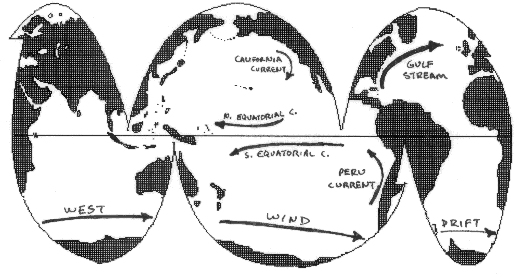1. northwest, north
2.

3.

4. The Equatorial Counter Current is found in the doldrums which are generally at about 5o N latitude (meteorological equator). Trade winds and the earth’s west to east rotation pile water up on the western side of an ocean, but in the doldrums surface winds are insufficient there to keep surface waters from flowing downhill from west to east.
5. The Equatorial Undercurrent flows from west to east, slightly below the surface, and exactly at 0o latitude (geographical equator). Although surface water has a difficult time flowing downhill (W to E) against the trade winds, subsurface water has no problem doing this. Coriolis effect deflects the west to east subsurface flow toward the equator and concentrates it into a powerful jet.
6. The Davidson current flows along the central and northern California coast. It flows to the north because fresh water runoff turns right due to Coriolis effect as it heads out to sea.
7. Coastal upwelling tends to occur on the western margin of a continent because west coasts are subject to cold, eastern boundary currents. Surface and bottom waters will both be cold and therefore of similar density, so less energy is needed to accomplish upwelling.
8. El Nino refers to a mass of warm water that flows from west to east across the equatorial Pacific about every 3 to 7 years. It is associated with heavy rain in the eastern Pacific (western Americas) and drought in the western Pacific (Indonesia and Australia). The blanket of warm buoyant water effectively shuts-off the upwelling of cold, dense, nutrient-rich bottom water.
9. Thermal expansion of equatorial surface waters results in a sea surface that is sloped toward the poles. Overall surface flow will therefore be toward the poles. Heat is lost on route to the poles so that by the time the surface currents reach the polar oceans they are cold and dense enough to sink to the bottom. Subsurface flow is generally toward the equator, balancing the surface flow away from the equator.
The Coriolis effect deflects the equator-bound subsurface flow towards the western margin of an ocean basin. Where wind-driven surface currents converge, downwelling occurs. Where surface currents diverge, upwelling occurs. This implies that there will be many water masses flowing at different levels in the patterns described by the theoretical model.
10. Sketch the pattern of deep ocean circulation in the Atlantic and label the water masses involved (see class handout).


8800 Grossmont College Drive
El Cajon, California 92020
619-644-7000
Accessibility
Social Media Accounts